By Jonathan Simon In plumbing, like many trades, knowledge is often shared plumber-to-plumber in the field. That allows experience to get passed from one generation to the next. But sometimes the information shared doesn’t keep up with new developments or, like a childhood game of “telephone,” gets distorted over time and becomes inaccurate. The result Read more
Plumbing

By Jonathan Simon
In plumbing, like many trades, knowledge is often shared plumber-to-plumber in the field. That allows experience to get passed from one generation to the next. But sometimes the information shared doesn’t keep up with new developments or, like a childhood game of “telephone,” gets distorted over time and becomes inaccurate. The result is the proliferation of “myths” that are accepted as true by some but are provably false. Here are five myths related to CPVC plumbing systems that the FlowGuard Gold® CPVC team has encountered in the field–and the truth behind the myth.
Myth 1: CPVC should be replaced when it shows signs of discoloration
It’s easy to see how some myths get started. A plumber may think that discoloration is an indication of structural weakness, decides the pipe needs to be replaced and passes that “tip” onto a younger plumber.
But older CPVC pipes that show signs of discoloration do not need to be replaced. CPVC naturally becomes more rigid as it ages and may discolor, but these factors do not increase the risk of failure in a properly installed and serviced system. In fact, the pressure-bearing capability of CPVC pipes improves with age, so, by that measure, an older CPVC pipe is actually stronger than it was when first installed.
It is recommended that plumbers use C-style cutters, a wheel cutter, or a fine-tooth saw when servicing older CPVC pipes, but there is no reason to remove the pipe from service due to discoloration. One of CPVC’s strengths is the material’s long service life—some of the first CPVC pipes ever installed back in the 1960s are still in service today–and discoloration is not a reason to shorten that service life.
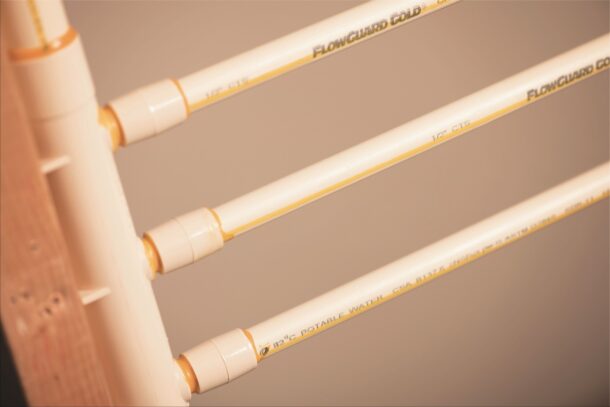
Myth 2: CPVC is difficult or slow to install
Some myths are rooted in misperceptions and false assumptions while others can be traced to competitors seeking to gain traction in a competitive market. The myth that CPVC is difficult to install falls into the second category.
CPVC plumbing systems are similar to copper in their design. Both are rigid systems that use socket-style fittings in which the pipe fits into the fitting. But CPVC is easier to work with than copper and the solvent welding process used to bond CPVC pipes and fittings is simple, easy to learn and does not require any special tools. CPVC plumbing systems install faster than copper and have installation times that compare favorably to PEX systems.
Independent research studies that measured installation times for CPVC and PEX systems found that CPVC trunk-and-branch systems install up to 17% faster than comparable PEX trunk-and-branch systems. A PEX mini-manifold system installed 10% faster than a CPVC trunk-and-branch system but used 21% more pipe and the added material costs outweighed the time savings. Most plumbers with experience using both materials have reported no noticeable speed difference between CPVC and PEX plumbing systems.
Myth 3: CPVC can’t handle higher pressures and temperatures
A review of material specifications will quickly dispel this myth. Plumbing codes require that domestic water plumbing systems be capable of handling at least 100 psi of pressure at 180°F without ballooning or bursting. FlowGuard Gold pipes and fittings not only meet this requirement but are pressure rated to 400 psi at room temperature and above 200 psi at all temperatures up to 140°F. When subjected to extreme quick-burst testing, a solvent-welded FlowGuard Gold CPVC plumbing system will not typically fail until the system reaches pressures of 1200 psi or higher.
In addition, CPVC isn’t subject to additional temperature and pressure limitations imposed by chlorinated water on other plastic plumbing systems (140° F and 80 psi). That makes CPVC ideal for higher temperature applications such as hot water lines. It can even support legionella mitigation strategies that store water above 140°F. In multi-story buildings, CPVC’s excellent pressure rating enables use of gravity-fed distribution systems and booster pumps that can introduce risks to other plastic plumbing systems.
Myth 4 CPVC is not as sustainable as other plumbing systems
You might expect a plastic piping system like CPVC to be less sustainable than a metal system like copper, but CPVC has excellent sustainability credentials.
FlowGuard Gold CPVC requires less energy to manufacture and produces fewer greenhouse gases over its service life than PEX and copper systems. The material’s long service life, enabled by its chlorine immunity, means less material is ultimately required to support the application. Plus, CPVC is recyclable through proper centers.
FlowGuard Gold CPVC is also the only residential plumbing system certified by Home Innovation Labs National Green Building Standard (NGBS) and has a lifecycle assessment to contribute to LEED certification.
Myth 5: CPVC is more expensive than other plastic plumbing systems
Plumbers who haven’t compared material costs can be forgiven for believing CPVC is one of the more expensive plumbing systems. After all, FlowGuard Gold CPVC is the only material in the industry that offers a warranty that isn’t voided by exposure to chlorinated water, putting it in a class by itself. It doesn’t make sense that it should be less expensive, but it is. According to a cost study done by a leading PEX manufacturer, CPVC material costs were half the cost of their own PEX system.
These savings come from two key areas: fittings and pipe sizing. While a PEX system contains about 30% fewer fittings than a CPVC system, those fittings (and the crimp, cinch or expansion rings that go with them) typically cost 3-5 times more than the comparable CPVC fitting. In addition, because those insert fittings introduce significant pressure drop at ½” diameters, PEX systems are typically upsized to use more 1” and ¾” pipe than required with a CPVC system, saving even more money. You can verify this yourself by comparing PEX and CPVC costs on your next job.
Better Information Leads to Better Service
Plumbers looking to deliver the best service to their customers and grow their business should be careful not to take everything they hear at face value. There are resources available that provide reliable information about plumbing systems, including manufacturer websites. To get more information on CPVC, visit the plumber’s resource center on the FlowGuard Gold website.

While he’s not busy with his day job working on hydronic heating systems, commercial and residential plumbing, backflow prevention and gas work, Chris Massaro (@nwo_plumber) loves playing guitar and recording music. Admiring the recent tattoo to commemorate his daughter’s birth, “I was in a bunch of bands throughout high school and recorded an album once Read more
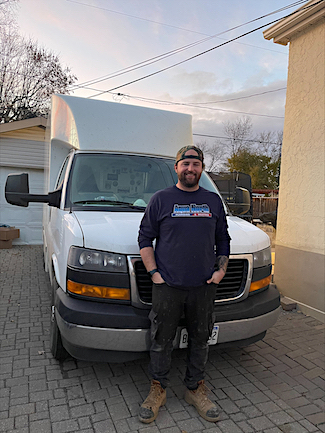 While he’s not busy with his day job working on hydronic heating systems, commercial and residential plumbing, backflow prevention and gas work, Chris Massaro (@nwo_plumber) loves playing guitar and recording music. Admiring the recent tattoo to commemorate his daughter’s birth, “I was in a bunch of bands throughout high school and recorded an album once. I don’t get around to it as much as I used to or like to, but I’m definitely making more time for that now,” says Massaro, owner/lead tech at Aqua North Plumbing and Heating Ltd., Thunder Bay, Ontario, Canada.
While he’s not busy with his day job working on hydronic heating systems, commercial and residential plumbing, backflow prevention and gas work, Chris Massaro (@nwo_plumber) loves playing guitar and recording music. Admiring the recent tattoo to commemorate his daughter’s birth, “I was in a bunch of bands throughout high school and recorded an album once. I don’t get around to it as much as I used to or like to, but I’m definitely making more time for that now,” says Massaro, owner/lead tech at Aqua North Plumbing and Heating Ltd., Thunder Bay, Ontario, Canada.
I take that back. Massaro also enjoys hanging out with friends and family, golfing and mountain biking. And, he definitely needs to get that grill time in—grill, smoke, BBQ. “Sometimes in that order, in one cook. Most of the time I do use the smoker though. I’ve been on a pulled pork kick lately. My favorite is some nice pork shoulders on the Traeger. It’s the ultimate dad activity, in my opinion,” says Massaro.
The work\life balance has been a struggle for Massaro; he realized one day that when you are running your own small business sometimes there isn’t a balance. You have to make the time and prioritize it. “Do what’s important to you and make time for the people and activities you love. And most importantly, take care of yourself! Because you’re worth it. Time stands still for no one so spend it wisely,” says Massaro.
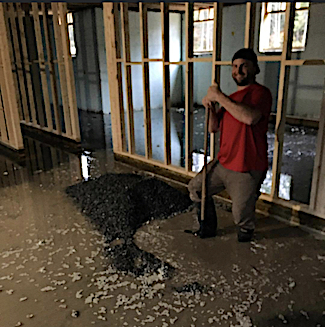 And that’s why staying physically fit and active is important to Massaro. “I’m always lifting, bending, up and down the stairs all day so it’s helpful to have a training regimen that supports that. And, it really helps to keep me in mental shape as well,” say Massaro.
And that’s why staying physically fit and active is important to Massaro. “I’m always lifting, bending, up and down the stairs all day so it’s helpful to have a training regimen that supports that. And, it really helps to keep me in mental shape as well,” say Massaro.
Even more important is eating right, says Massaro. “We use a lot of energy in a day in the trades so we have to keep that fire fed. All of this allows me to stay energized all day and still have plenty of gas in the tank when I get home for family time,” continues Massaro.
Massaro’s foray into the trades started when he starting working for the family business as a plumbing apprentice at the age of 13. “Made best friends with my shovel and we went to work. Thankfully, I graduated from digging trenches and went on to start really learning about the ins and outs of the trade,” recalls Massaro.
Over the next few years, Massaro spent most days plumbing residential systems with a few commercial jobs sprinkled in here and there while working for my father. “It was nice to be doing a bit of everything and not just strictly one area of the trade, which I felt was important to be a well-rounded tech.
Once Massaro had a few years under his belt, he did a lot of remote northern work for fly-in communities. “Those big jobs we did up there really sharpened my time and material management skills,” says Massaro.
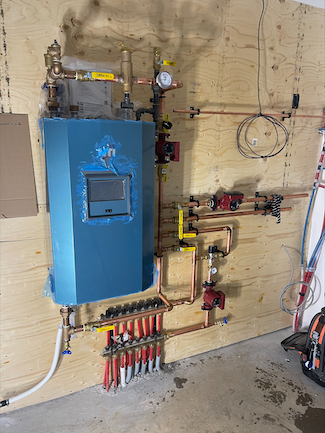 In addition, the high school Massaro attended offered a cooperative education program where he was able to gain work experience hours toward his apprenticeship if he chose to stick with plumbing. “I would go to regular classes for the morning periods then co-op at Aqua North in the afternoon,” says Massaro.
In addition, the high school Massaro attended offered a cooperative education program where he was able to gain work experience hours toward his apprenticeship if he chose to stick with plumbing. “I would go to regular classes for the morning periods then co-op at Aqua North in the afternoon,” says Massaro.
As a side note, Massaro says that if your local high school offers a cooperative education program, he highly recommends getting involved. “It’s a really pressure-free way to get your feet wet in whatever trades the school offers,” says Massaro. “I always try to take on one co-op student per year and leave them with a positive experience in the trade. I feel that’s the best way for kids to feel out what they want to do. And, don’t be afraid to ask questions!”
Next, after getting all of his trade school and work hours complete, Massaro then wrote his exam for his certificate of qualification in plumbing. Shortly thereafter, Massaro bought the family business, and the rest is history.
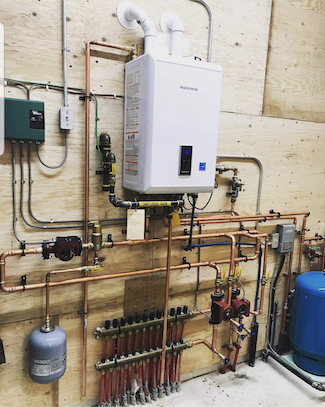 As fourth-generation plumber, Massaro has had some great mentors in his career, with plenty of help and guidance from his father and grandfather in learning new and old ways of plumbing. “If my great grandfather was around then I’m sure he would have some real old school stuff to show me.”
As fourth-generation plumber, Massaro has had some great mentors in his career, with plenty of help and guidance from his father and grandfather in learning new and old ways of plumbing. “If my great grandfather was around then I’m sure he would have some real old school stuff to show me.”
And while Massaro doesn’t consider himself a role model, he’s always willing and ready to help others to do their best at work, and life in general. “I’ve learned a lot over the years and sharing the experiences and knowledge with up-and-coming tradespeople is paramount,” says Massaro.
For Massaro, he loves building something from nothing and executing the job. “Sometimes just sitting back after the job is done and being like ‘damn we really did that.’”
Perception Change
The perception of the industry needs to change, says Massaro. “I think the wheels are turning on that as we speak but we’ve got a long way to go.”
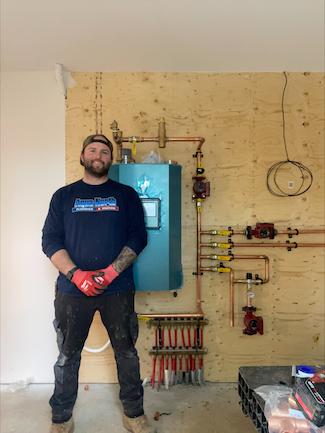 Social media is that vehicle for the instrument of change as it’s an easy way to showcase contractor work, and connect with other professionals. “There’s a solid amount of tradespeople out there doing an amazing job. If we can show people that there’s more to plumbing than just plunging toilets, fixing leaks, and back-breaking work, then I think that’s a win,” says Massaro.
Social media is that vehicle for the instrument of change as it’s an easy way to showcase contractor work, and connect with other professionals. “There’s a solid amount of tradespeople out there doing an amazing job. If we can show people that there’s more to plumbing than just plunging toilets, fixing leaks, and back-breaking work, then I think that’s a win,” says Massaro.
Whether it’s new and better tools, techniques, business knowledge, etc., Massaro has learned so much on social media. “It’s awesome that we can connect with people and have such a great community sharing tricks of the trade, meet-ups or even debate if it’s tape then dope—which it is—or dope then tape,” says Massaro.
In the end, as Massaro sets his sights on his career and further enriching his life, a good bucket list item to check off would be getting a recreational pilot’s license. “Always wanted to get into aviation in some way.”
The sky’s the limit.

While endorsements and referrals are used in the early process to narrow down selections, homeowners look at logistical considerations before making their final hiring decision. And, according to Lowe’s State of the Pro report, price is almost always a top factor for homeowners, with availability to start and final written bid coming in close behind Read more
 While endorsements and referrals are used in the early process to narrow down selections, homeowners look at logistical considerations before making their final hiring decision. And, according to Lowe’s State of the Pro report, price is almost always a top factor for homeowners, with availability to start and final written bid coming in close behind. Learn more about homeowners’ expectations and how to meet them here.
While endorsements and referrals are used in the early process to narrow down selections, homeowners look at logistical considerations before making their final hiring decision. And, according to Lowe’s State of the Pro report, price is almost always a top factor for homeowners, with availability to start and final written bid coming in close behind. Learn more about homeowners’ expectations and how to meet them here.
Falls Church, Va. — The Plumbing-Heating-Cooling Contractors — National Association’s (PHCC) Educational Foundation is proud to announce the winners of the national plumbing and HVAC apprentice contests. The contests were held October 5th & 6th in Charlotte, North Carolina on the tradeshow floor during the PHCC—National Association’s CONNECT 2022 event. A total of eighteen plumbing Read more
Falls Church, Va. — The Plumbing-Heating-Cooling Contractors — National Association’s (PHCC) Educational Foundation is proud to announce the winners of the national plumbing and HVAC apprentice contests. The contests were held October 5th & 6th in Charlotte, North Carolina on the tradeshow floor during the PHCC—National Association’s CONNECT 2022 event. A total of eighteen plumbing and ten HVAC apprentices from across the nation took part in the contests.
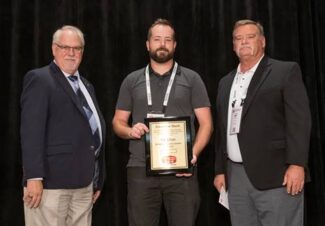
PHCC Educational Foundation Chair Kevin Tindall, Plumbing Contest Winner Jake Elsbecker and Plumbing Contest Chair Jim Steinle.
Plumbing Apprentice Contest Winners
- First place: Jake Elsbecker, from Midwestern Mechanical in Spencer, Iowa. He was sponsored by Zoeller.
- Second place: Scott Hicks, Jr. from TD Industries in Houston, Texas. He was sponsored by the International Code Council.
- Third place: Alex Estevez from B Wagner Contracting in Allentown, New Jersey. He was sponsored by the Copper Development Association.
HVAC Apprentice Contest Winners
- First Place: Sebastian Uhde, from Magnolia Plumbing, Heating and Cooling in Washington D.C. He was sponsored by the PHCC National Auxiliary.
- Second place: Harrison Bosler, from Howe Inc. in Sioux Falls, South Dakota. He was sponsored by NIBCO, INC.
- Third Place: Sean Reed, from Reddick and Sons in Manassas, Virginia. He was sponsored by RIDGID.
The plumbing apprentices were required rough-in a bathroom system. The set-up includes a toilet, sink and shower, complete with supply, waste and vent lines, plus cleanouts and extra features designed to test the contestants’ knowledge and skills. The test set-up includes a variety of pipe materials – cast iron, copper, and PVC and corresponding joining methods.
The HVAC competitors were required to complete a written test, demonstrate proper brazing techniques and perform a hands-on diagnostic on an HVAC package unit, with system errors created by the Foundation’s contractor volunteers for the competition. The competitors also had to perform a pressure and leak test, demonstrate proper refrigerant recovery procedures and the ability to accurately take a variety of instrument readings.
A dedicated team of contractor volunteers arrived two days before the competitions to assemble the competitor test benches, distribute the materials and supplies and setup the testing areas. They monitor the competitions, evaluate the apprentices’ work and provide constructive feedback on each competitor’s performance following the event.

Service Experts Career Academy (SECA) is partnering with the National Center for Construction Education and Research (NCCER) to offer a debt-free path to a lifelong career as an HVAC technician or plumber. The SECA program is training dozens of apprentices across the country to meet the growing demand for HVAC technicians and plumbers. According to Read more
Service Experts Career Academy (SECA) is partnering with the National Center for Construction Education and Research (NCCER) to offer a debt-free path to a lifelong career as an HVAC technician or plumber. The SECA program is training dozens of apprentices across the country to meet the growing demand for HVAC technicians and plumbers. According to the U.S. Bureau of Labor Statistics, 401,100 job openings for HVAC technicians are expected every year for the next decade. After a positive response to the HVAC training program, SECA and NCCER will also train aspiring plumbers beginning January 2023.
Service Experts welcomes any applicants interested in starting their professional careers debt-free. While trade schools, four-year colleges, associates degrees and other hands-on training programs can cost $7,000 or more annually, SECA pays HVAC apprentices throughout all four years of the training program, while giving them virtual, hands-on and ride along learning opportunities.
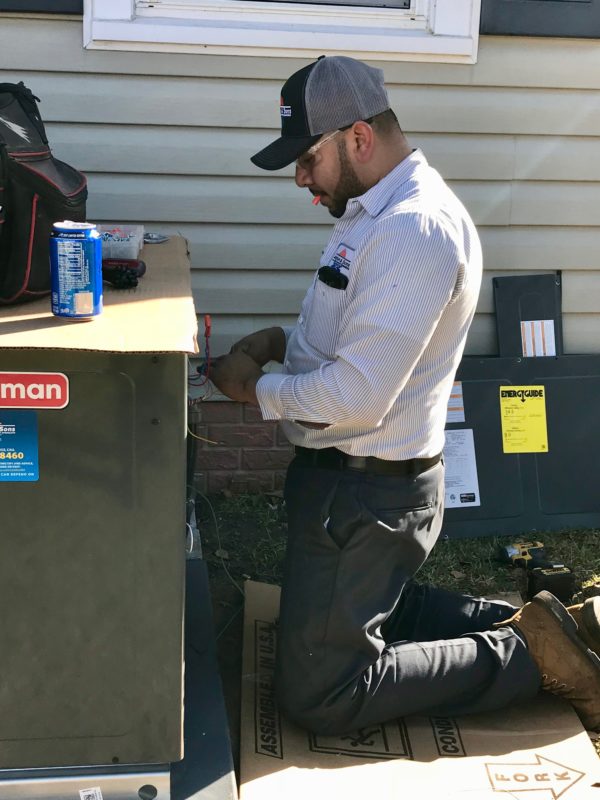
“We are opening our doors to anyone interested in taking that first step,” says Tom Essing, a SECA technical trainer in Michigan. “Whether you have prior experience or are a fresh mind with no experience at all, we want good, quality people who are enthusiastic about learning and are looking for a fulfilling career.”
“The construction and maintenance workforces are aging and it’s important we recruit and train the next generation of craft professions,” said NCCER President and CEO Boyd Worsham. “It will take all of us working together to make a real impact on the industry as we strive to fill the skills gap.”
In a traditionally male-dominated field, SECA is making strides by reaching out to women who might be interested in HVAC technician training. According to the U.S. Bureau of Labor Statistics, women only make up 1.5 percent of HVAC professionals and 2.1 percent of plumbers in 2021; however, nine percent of students in SECA are women.
“I’ve always had trouble finding a job that I could grow in. Thankfully the apprenticeship program has allowed me to do just that and get my certification in HVAC,” said Kailey Scott, a current apprentice in SECA. “In this field there are no limits, and I’m more than excited to exceed beyond my limits thanks to this program.”
“When I started working in HVAC, it was a male-dominated field, and now it’s changing to be more diverse,” says Essing. “It’s positive to see this shift and we look forward to continuing to support anyone interested in the HVAC field.”
In addition to paying apprentices, SECA offers a comprehensive employment benefits package made to support each student and their families on day one of their training. According to Essing, SECA wants to attract recruits away from other jobs by offering them the rounded benefits of a career, including two weeks of paid time off, a 401(k) plan with company matching and health insurance programs. Students also get a $1,000 tool kit with hand tools, gauges, electric beaters and more that is theirs when they complete the program. SECA graduates can also take advantage of Service Experts locations spread across the country. Service Experts serves over 90 locations across America, and certified program graduates have the opportunity to work with any Service Experts location, from San Francisco to Miami.
The pay, opportunities and benefits aren’t the only way that SECA accommodates aspiring HVAC technicians.
“Going virtual has helped get everyone together, all at the same time,” says Ken Benedetto, a SECA technical trainer in New York. “Having virtual class in the morning has been a huge benefit, students are ready to learn before they start their day.”
After completing their SECA training and earning their NCCER credentials, program graduates can earn more than many fields that require a four-year college degree, without having to navigate their lives around repaying expensive school loans.
“If you are looking for a career that will support you for your entire lifetime and give you four years of schooling without debt, jumpstart your future with Service Experts Career Academy,” said Jim Hughes, SECA director.
